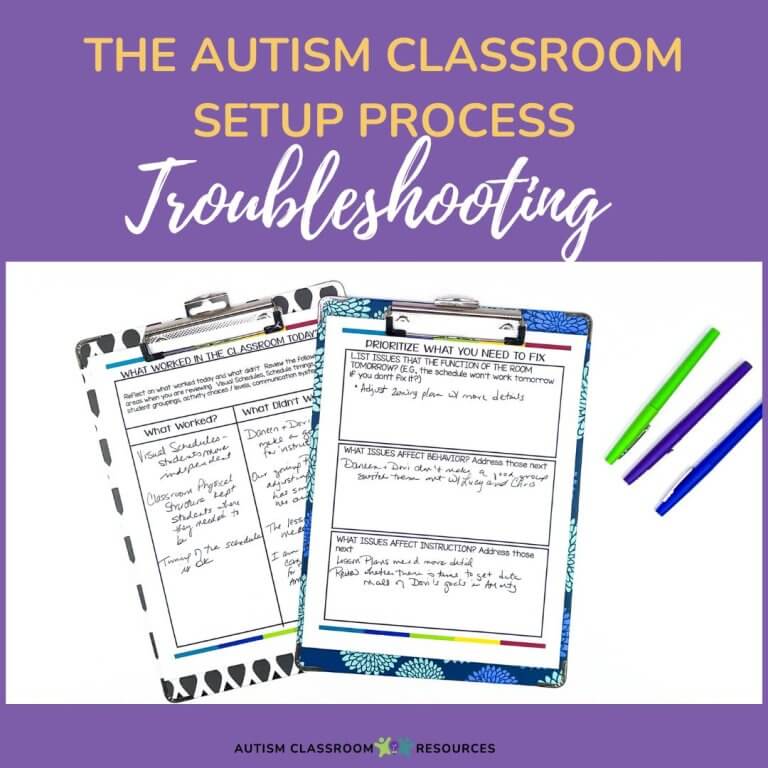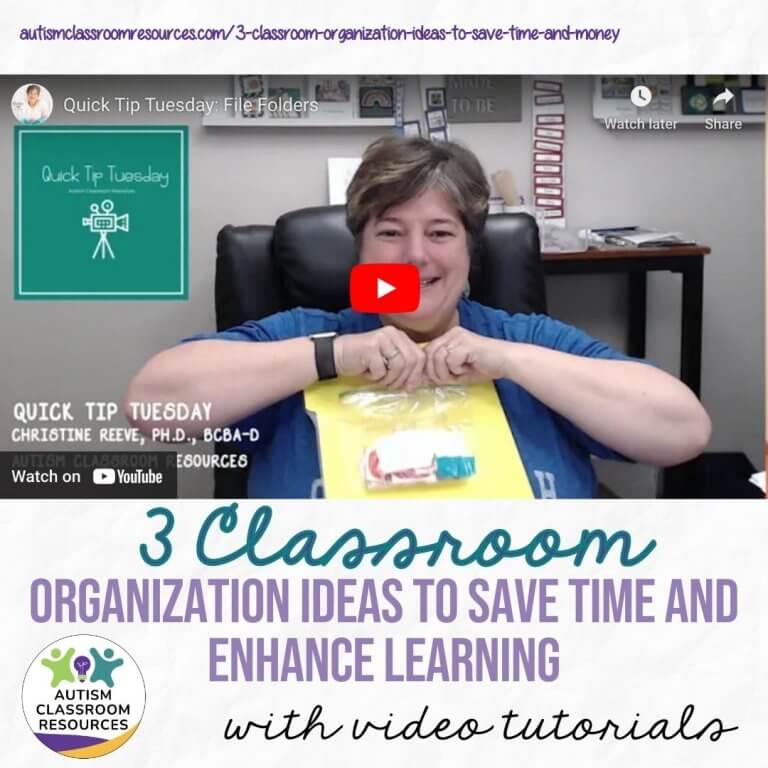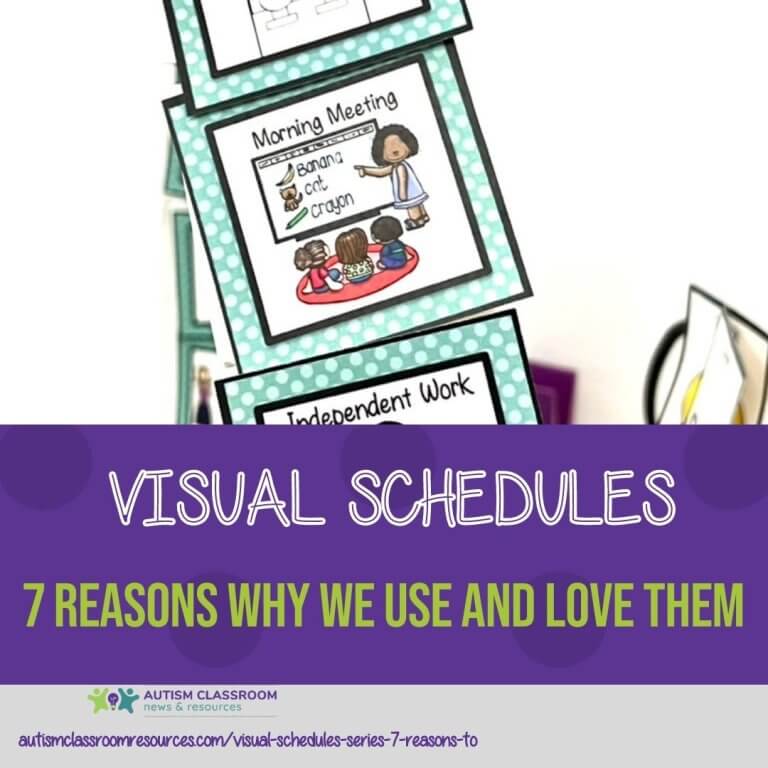Sharing is caring!
 Don’t forget to hop over to check out A Special Sparkle, our new collaborative special education blog. Great stuff with lots of freebies this week.
Don’t forget to hop over to check out A Special Sparkle, our new collaborative special education blog. Great stuff with lots of freebies this week.
Just a couple more posts in the visual schedule series to round it out. Before my marathon of posts about mini-schedules, I talked about the use of individual schedules to navigate the transitions of the day. One of the things that I often see get left out of the instruction process of individual schedule is a way to help the student connect the visual to the place he or she is going. It is important to remember that schedules are not always intuitive to the student; just giving him a schedule does not assure he knows how to use it. He has to be taught.
Using Visual Schedules
For many students using schedules, one of the areas they haven’t learned is what the visuals mean about where to go or what to do. A picture without meaning is fairly useless. Over the years, I have seen many instances where a student has a schedule and she goes through the motions of checking it by taking off the visual as a task is completed. However, when given a new routine, she doesn’t know what to do or where to go when she checks her schedule. This is a good sign that the visuals are not concrete or meaningful to her. Just moving the visual to a finished envelope at the bottom of the schedule is not meaningful for many students. Enter check-in stations. In the picture on the left you see a number of examples from photos of the teacher on the outside of an envelope, to plastic envelopes, to boards and folders.
Now, there are many different ways to present visual schedules and I’ve given a number of examples. For students who understand the visuals (or the written list) they may not need a check-in station. However, check-in stations are essential for students just learning schedules and also help staff know where activities will take place.
What is a check-in station?
 And that is a reasonable question as they often aren’t talked about when people present schedules. Check-in stations are a board, envelope or folder where the student takes the visual, matches it to an identical visual and “checks in” to the activity. Thus the student carries a transition visual to the correct area and matches it to check in. This helps students to understand what to look for when their schedule gives them information. It also means that teachers are more consistent in where activities take place, which is great for classroom management. In this picture (to the left) the students check in on a board for snack. In some classes, we even put the Velcro on the picture itself to help students understand and match on top of the identical picture. We will do anything to make it more concrete. In this picture you also see a basket with a finished sign under the check-in board. This is so that this board, when used for another activity later in the day, can be easily cleared. Then at the end of the day, the teachers can just gather the visuals out of the baskets around the room to reset the schedule.
And that is a reasonable question as they often aren’t talked about when people present schedules. Check-in stations are a board, envelope or folder where the student takes the visual, matches it to an identical visual and “checks in” to the activity. Thus the student carries a transition visual to the correct area and matches it to check in. This helps students to understand what to look for when their schedule gives them information. It also means that teachers are more consistent in where activities take place, which is great for classroom management. In this picture (to the left) the students check in on a board for snack. In some classes, we even put the Velcro on the picture itself to help students understand and match on top of the identical picture. We will do anything to make it more concrete. In this picture you also see a basket with a finished sign under the check-in board. This is so that this board, when used for another activity later in the day, can be easily cleared. Then at the end of the day, the teachers can just gather the visuals out of the baskets around the room to reset the schedule.  In the picture on the right, there are two examples of check-in envelopes we have started using pretty standardly. These are cardboard expanding file folder inserts that are used in offices for large files. They are great when you fold down the top and put the visual on the outside. We frequently use areas of the room for multiple purposes, so the visual on the front is typically Velcroed to the front of the envelope. We store the extra ones in the envelope and we zone (schedule) a staff member in to change out the visuals before the transition. Then the students drop their visuals in the envelope. At the end of the day, you just gather up the visuals from the envelopes. In the classroom of the picture on the top, all the students were using picture schedules. For the classroom of the picture on the bottom, you see an object (a chair for work time) because several of the students were using object schedules. It is important to make sure that your check-in visuals match your students’ schedules. So, do you use check-in stations in your classroom? How do you use them? What issues have you had with implementing them? Sound off in the comments!
In the picture on the right, there are two examples of check-in envelopes we have started using pretty standardly. These are cardboard expanding file folder inserts that are used in offices for large files. They are great when you fold down the top and put the visual on the outside. We frequently use areas of the room for multiple purposes, so the visual on the front is typically Velcroed to the front of the envelope. We store the extra ones in the envelope and we zone (schedule) a staff member in to change out the visuals before the transition. Then the students drop their visuals in the envelope. At the end of the day, you just gather up the visuals from the envelopes. In the classroom of the picture on the top, all the students were using picture schedules. For the classroom of the picture on the bottom, you see an object (a chair for work time) because several of the students were using object schedules. It is important to make sure that your check-in visuals match your students’ schedules. So, do you use check-in stations in your classroom? How do you use them? What issues have you had with implementing them? Sound off in the comments!
Until next time,







